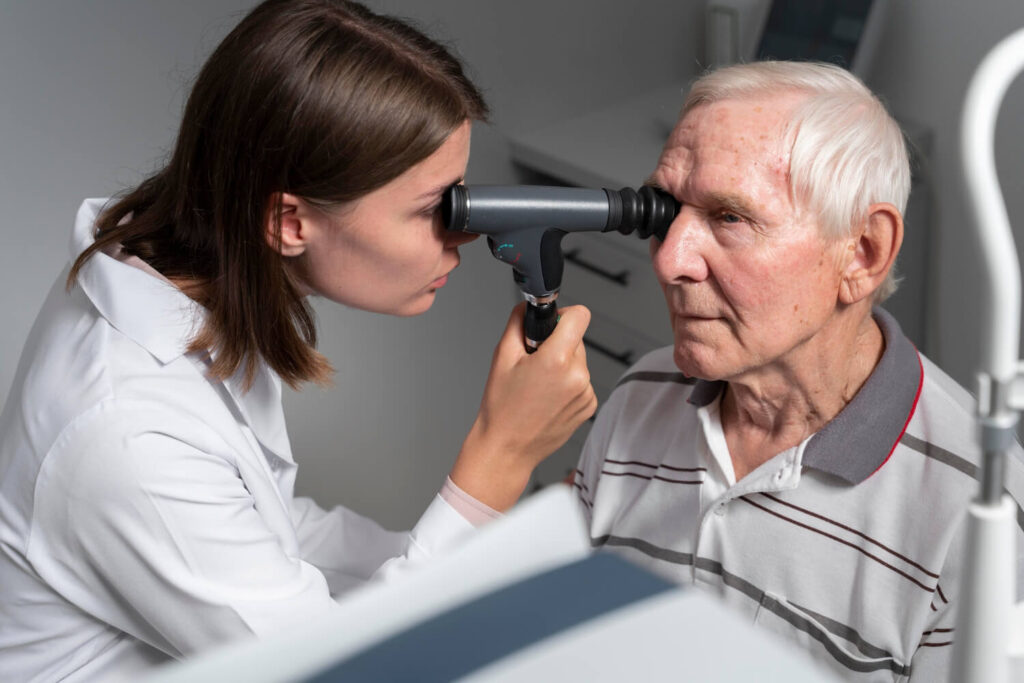Eyesight naturally becomes blurry as we age. Individuals can suffer due to impaired lenses of the eye or cataracts. Cataracts are a common eye condition that affects millions of people worldwide. They occur when the eye’s lens clouds, leading to blurry vision and other visual impairments. Understanding the cataract symptoms is essential for early detection and appropriate treatment. In this article, we will explore the ten most common cataract symptoms and how they can affect overall eye health. Let’s begin!
What is Cataract

Cataract happens when the lens behind the pupil of your eye is clouded. This lens is located behind the iris, the colored part of the eye. This clouding can occur gradually and may not initially cause any noticeable symptoms. However, over time, the clouding of the lens can affect the clarity and quality of one’s vision, making daily activities more challenging.
When light enters the eye, it passes through the clear lens to reach the retina at the back of the eye. The lens is responsible for focusing light onto the retina, which then sends signals to the brain for visual recognition. However, when cataracts develop, the cloudiness in the lens obstructs the passage of light, leading to blurred or distorted vision.
As cataracts progress, individuals may experience difficulty with tasks such as reading, driving, or recognizing faces. Colors may appear faded or yellowed, and glares may become more bothersome. In severe cases, cataracts can significantly impact a person’s independence and quality of life. That’s because it can also lead to vision loss.
Cataract vs Glaucoma
Cataracts and glaucoma are both eye conditions that can affect vision, but they are different. While cataracts result from the clouding of the lens, glaucoma is characterized by damage to the optic nerve, often due to increased pressure within the eye.
One key difference between cataracts and glaucoma is that cataracts are usually age-related and develop slowly over time, whereas glaucoma can progress rapidly and without warning. Both conditions require prompt attention from eye care professionals to prevent further vision loss.
Causes and Risk Factors of Cataracts
Before we delve into the different cataract symptoms, let’s discuss how individuals can develop cataracts. Several factors can contribute to the development of cataracts. Exposure to the following factors means a higher risk of being susceptible to cataracts.
- Age: Cataracts are most commonly associated with aging. Older adults may have their proteins in the lens break down and clump together.
- Genetics: Some people may be more genetically predisposed to cataracts, meaning they are more likely to develop the condition at an earlier age.
- Exposure to UV radiation: Prolonged exposure to sunlight and UV radiation can increase the risk of developing cataracts.
- Smoking and alcohol consumption: Smoking and excessive alcohol consumption have been linked to an increased risk of cataracts.
- Medical conditions: Certain medical conditions, such as diabetes and high blood pressure, can also increase the risk of cataracts.
It is essential to have regular eye exams to monitor the health of your eyes and detect any early signs of cataracts. Early detection can help in managing the condition effectively and preserving vision for as long as possible.
Identifying Cataract Symptoms

Whether or not you have cataracts, it’s important to recognize the common signs involved. Identifying such cataract symptoms can help individuals to take over their health and begin early intervention.
While symptoms may vary from person to person, the following ten symptoms are commonly associated with cataracts:
1. Blurred or Cloudy Vision
One of the first signs of cataracts is the gradual blurring or clouding of vision. It occurs when the fibers and proteins clump, which makes it harder for the path of light. It then results in blurred images as the retina can’t recognize it.
2. Difficulty with Night Vision
Aside from the overall clouded vision as one of the cataract symptoms, it can also affect night vision. Most patients experience difficulty seeing at night due to lack of light. With a part of your eye being compromised, it further makes vision difficult at night.
3. Sensitivity to Light and Glare
Meanwhile, patients with cataracts may also experience cataract symptoms like sensitivity to light. People with cataracts often experience increased sensitivity to light, especially bright sunlight or glare from artificial lighting. This can cause discomfort or even pain when exposed to intense light sources.
4. Seeing “Halos” Around Lights
Another common cataract symptom is the perception of “halos” around lights. Commonly, people tend to see halos due to unusual entering of light. For instance, if the center of the lens is compromised due to the clouded lens, then the light will have a hard time passing. Thus, resulting in halo visions.
5. Frequent Changes in Eyeglass or Contact Lens Prescription
If you find that your prescription for glasses or contact lenses needs frequent adjustments, it only shows that one of the sights of cataract symptoms is present. It is considered a warning sign as cataract won’t go away on its own. In short, it can only progress its effect on your eye health, which shows why your prescription changes.
6. Fading or Yellowing of Colors
Furthermore, one of the most important cataract symptoms is the yellowing of your vision. When a person has cataracts, their vision becomes yellow or brown because of the light tint that passes through. Unfortunately, this scenario affects the sight of patients, making it difficult to differentiate and recognize other colors.
7. Double Vision in a Single Eye
On the other hand, another cataract symptom involves eye problems like double vision. Double vision, also known as diplopia can make it challenging to focus on objects, due to second sight. It can lead to a distorted perception of depth and clarity.
8. Trouble with Bright Colors
In connection with the other cataract symptoms, patients with the eye condition may also notice tone-downed hues of color. Some patients may not recognize bright colors, specifically blues and purples. These colors can appear washed out or less vibrant.
9. Loss of Depth Perception
Moreover, loss of depth of perception is included in the common cataract symptoms due to the cloudy lens. Cataracts can affect depth perception, making it challenging to judge distances accurately. While the initial stage of cataract won’t equate to blindness, still, the difficulty in seeing is difficult. It can be dangerous when driving or participating in activities that require precise spatial awareness.
10. Need for Brighter Light for Reading and Other Activities
Lastly, patients can have trouble reading and doing other activities that require eyesight. With the lenses compromised, patients won’t understand what they see due to lack of light. The scenario affects one’s reading vision and the decreased lens transparency can make it harder for light to reach the retina. Thus, resulting in the need for increased illumination.
While these ten symptoms are commonly associated with cataracts, it is important to note that not everyone will experience all of them. Some individuals may only have a few cataract symptoms, while others may have a combination of several. Additionally, the severity of symptoms can vary from person to person.
If you are experiencing any of these symptoms or suspect that you may have cataracts, it is essential to consult with an eye care provider. They can perform a comprehensive eye examination to determine the presence and severity of cataracts, as well as discuss potential treatment options.
Managing Cataract Symptoms

As mentioned, the lens of your eye will become cloudy if you have a cataract. It will even progress in adulthood years, making it difficult to function. In that case, finding how to manage the condition early is vital to prevent loss of vision in the future.
Regular Eye Exam
One way to manage the condition is through an eye exam with an eye doctor. This examination allows you to monitor your eyesight, especially if certain symptoms are occurring. Once the doctor recognizes the presence of cataracts, they’ll proceed with treatment options.
Protective Practices
In addition, there are protective choices that patients with cataract symptoms can try. If a non-invasive method is your goal, protecting the eyes should work. Wearing sunglasses with UV protection and quitting smoking can help prevent or slow down the progression of cataracts.
Eating Healthy
Maintaining a healthy diet rich in antioxidants like vitamins C and E may also help slow down cataract progression. Foods like green leafy vegetables, fruits, and nuts can contribute to overall eye health and potentially delay the need for cataract surgery in some cases.
Cataract surgery
Now, in terms of invasive choice for managing cataract symptoms, cataract surgery will be recommended by doctors. During the procedure, the cloudy lens is removed and replaced with an artificial lens or intraocular lens to restore clear vision. The surgery is usually quick and has a high success rate in improving vision for most patients.
Final Takeaway
Cataracts are one of the health threats that everyone must understand deeply. This eye condition has the power to potentially result in vision loss, which can be challenging to have. That’s because eyesight is one of the crucial senses that people use daily. In that case, monitoring one’s health by referring to the 10 common cataract symptoms will help you manage your eye health.
If any symptoms persist, it’s best to contact a health doctor to identify how to manage this condition. Book an online consultation with an ophthalmologist today!
